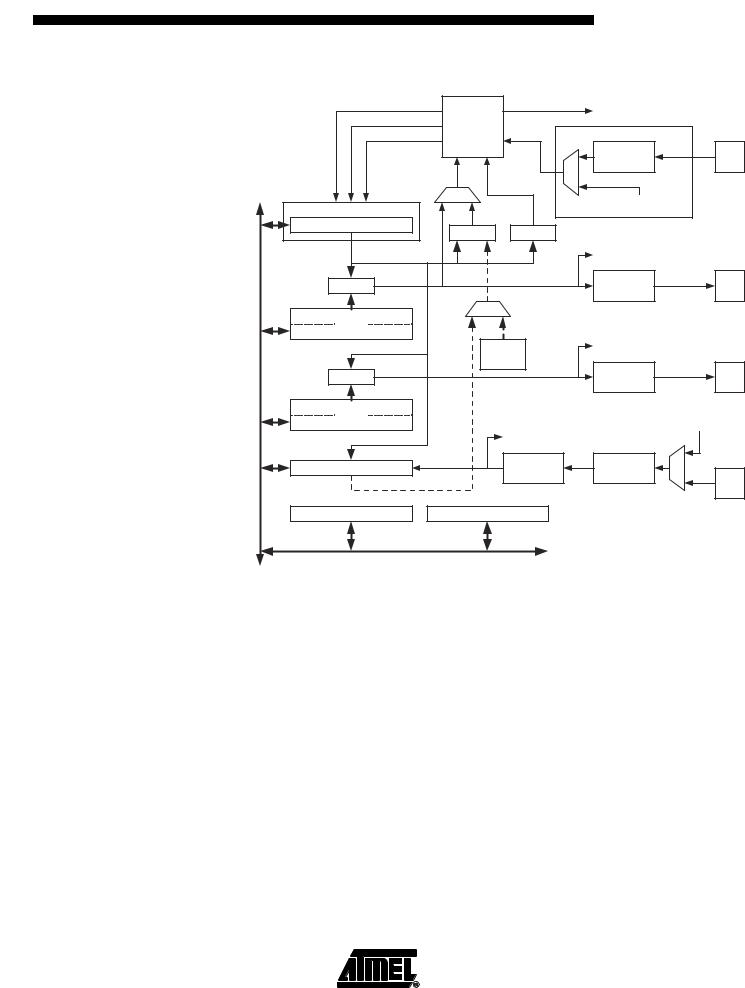
- •Features
- •Pin Configurations
- •Disclaimer
- •Overview
- •Block Diagram
- •Pin Descriptions
- •Port A (PA7..PA0)
- •Port B (PB7..PB0)
- •Port C (PC7..PC0)
- •Port D (PD7..PD0)
- •RESET
- •XTAL1
- •XTAL2
- •AVCC
- •AREF
- •AVR CPU Core
- •Introduction
- •Architectural Overview
- •Status Register
- •Stack Pointer
- •Interrupt Response Time
- •SRAM Data Memory
- •Data Memory Access Times
- •EEPROM Data Memory
- •EEPROM Read/Write Access
- •I/O Memory
- •Clock Systems and their Distribution
- •CPU Clock – clkCPU
- •I/O Clock – clkI/O
- •Flash Clock – clkFLASH
- •ADC Clock – clkADC
- •Clock Sources
- •Default Clock Source
- •Crystal Oscillator
- •External RC Oscillator
- •External Clock
- •Timer/Counter Oscillator
- •Idle Mode
- •Power-down Mode
- •Power-save Mode
- •Standby Mode
- •Extended Standby Mode
- •Analog to Digital Converter
- •Analog Comparator
- •Brown-out Detector
- •Internal Voltage Reference
- •Watchdog Timer
- •Port Pins
- •Resetting the AVR
- •Reset Sources
- •Power-on Reset
- •External Reset
- •Brown-out Detection
- •Watchdog Reset
- •Watchdog Timer
- •Interrupts
- •I/O Ports
- •Introduction
- •Configuring the Pin
- •Reading the Pin Value
- •Unconnected pins
- •Alternate Port Functions
- •Alternate Functions of Port A
- •Alternate Functions of Port B
- •Alternate Functions of Port C
- •Alternate Functions of Port D
- •Port A Data Register – PORTA
- •Port B Data Register – PORTB
- •Port C Data Register – PORTC
- •Port D Data Register – PORTD
- •External Interrupts
- •8-bit Timer/Counter0 with PWM
- •Overview
- •Registers
- •Definitions
- •Counter Unit
- •Output Compare Unit
- •Force Output Compare
- •Modes of Operation
- •Normal Mode
- •Fast PWM Mode
- •Phase Correct PWM Mode
- •Internal Clock Source
- •Prescaler Reset
- •External Clock Source
- •16-bit Timer/Counter1
- •Overview
- •Registers
- •Definitions
- •Compatibility
- •Counter Unit
- •Input Capture Unit
- •Input Capture Trigger Source
- •Noise Canceler
- •Using the Input Capture Unit
- •Output Compare Units
- •Force Output Compare
- •Modes of Operation
- •Normal Mode
- •Fast PWM Mode
- •Phase Correct PWM Mode
- •8-bit Timer/Counter2 with PWM and Asynchronous Operation
- •Overview
- •Registers
- •Definitions
- •Counter Unit
- •Output Compare Unit
- •Force Output Compare
- •Modes of Operation
- •Normal Mode
- •Fast PWM Mode
- •Phase Correct PWM Mode
- •Timer/Counter Prescaler
- •SS Pin Functionality
- •Slave Mode
- •Master Mode
- •SPI Control Register – SPCR
- •SPI Status Register – SPSR
- •SPI Data Register – SPDR
- •Data Modes
- •USART
- •Overview
- •AVR USART vs. AVR UART – Compatibility
- •Clock Generation
- •External Clock
- •Synchronous Clock Operation
- •Frame Formats
- •Parity Bit Calculation
- •USART Initialization
- •Parity Generator
- •Disabling the Transmitter
- •Receiver Error Flags
- •Parity Checker
- •Disabling the Receiver
- •Flushing the Receive Buffer
- •Asynchronous Data Recovery
- •Using MPCM
- •Write Access
- •Read Access
- •Two-wire Serial Interface
- •Features
- •TWI Terminology
- •Electrical Interconnection
- •Transferring Bits
- •START and STOP Conditions
- •Address Packet Format
- •Data Packet Format
- •Overview of the TWI Module
- •SCL and SDA Pins
- •Bit Rate Generator Unit
- •Bus Interface Unit
- •Address Match Unit
- •Control Unit
- •TWI Register Description
- •TWI Bit Rate Register – TWBR
- •TWI Control Register – TWCR
- •TWI Status Register – TWSR
- •TWI Data Register – TWDR
- •Using the TWI
- •Transmission Modes
- •Master Transmitter Mode
- •Master Receiver Mode
- •Slave Receiver Mode
- •Slave Transmitter Mode
- •Miscellaneous States
- •Analog Comparator
- •Analog Comparator Multiplexed Input
- •Features
- •Operation
- •Starting a Conversion
- •Differential Gain Channels
- •Changing Channel or Reference Selection
- •ADC Input Channels
- •ADC Voltage Reference
- •ADC Noise Canceler
- •Analog Input Circuitry
- •ADC Accuracy Definitions
- •ADC Conversion Result
- •ADLAR = 0
- •ADLAR = 1
- •Features
- •Overview
- •Test Access Port – TAP
- •TAP Controller
- •PRIVATE0; $8
- •PRIVATE1; $9
- •PRIVATE2; $A
- •PRIVATE3; $B
- •Bibliography
- •Features
- •System Overview
- •Data Registers
- •Bypass Register
- •Device Identification Register
- •Reset Register
- •Boundary-scan Chain
- •EXTEST; $0
- •IDCODE; $1
- •SAMPLE_PRELOAD; $2
- •AVR_RESET; $C
- •BYPASS; $F
- •Scanning the Digital Port Pins
- •Scanning the RESET Pin
- •Scanning the Clock Pins
- •Scanning the ADC
- •Features
- •Application Section
- •BLS – Boot Loader Section
- •Read-While-Write and no Read-While-Write Flash Sections
- •Boot Loader Lock Bits
- •Performing a Page Write
- •Using the SPM Interrupt
- •Setting the Boot Loader Lock Bits by SPM
- •Reading the Fuse and Lock Bits from Software
- •Preventing Flash Corruption
- •Fuse Bits
- •Latching of Fuses
- •Signature Bytes
- •Calibration Byte
- •Signal Names
- •Parallel Programming
- •Enter Programming Mode
- •Chip Erase
- •Programming the Flash
- •Programming the EEPROM
- •Reading the Flash
- •Reading the EEPROM
- •Programming the Lock Bits
- •Reading the Signature Bytes
- •Reading the Calibration Byte
- •SPI Serial Downloading
- •Data Polling Flash
- •Data Polling EEPROM
- •AVR_RESET ($C)
- •PROG_ENABLE ($4)
- •PROG_COMMANDS ($5)
- •PROG_PAGELOAD ($6)
- •PROG_PAGEREAD ($7)
- •Data Registers
- •Reset Register
- •Programming Enable Register
- •Virtual Flash Page Read Register
- •Programming Algorithm
- •Entering Programming Mode
- •Leaving Programming Mode
- •Performing Chip Erase
- •Programming the Flash
- •Reading the Flash
- •Programming the EEPROM
- •Reading the EEPROM
- •Programming the Fuses
- •Programming the Lock Bits
- •Reading the Signature Bytes
- •Reading the Calibration Byte
- •Electrical Characteristics
- •Absolute Maximum Ratings*
- •DC Characteristics
- •External Clock Drive Waveforms
- •External Clock Drive
- •Two-wire Serial Interface Characteristics
- •ADC Characteristics
- •Register Summary
- •Instruction Set Summary
- •Ordering Information
- •Packaging Information
- •Errata
- •ATmega32 Rev. A
- •Datasheet Change Log for ATmega32
- •Changes from Rev. 2503E-09/03 to Rev. 2503F-12/03
- •Changes from Rev. 2503D-02/03 to Rev. 2503E-09/03
- •Changes from Rev. 2503C-10/02 to Rev. 2503D-02/03
- •Changes from Rev. 2503B-10/02 to Rev. 2503C-10/02
- •Changes from Rev. 2503A-03/02 to Rev. 2503B-10/02
- •Table of Contents

16-bit Timer/Counter1
Overview
The 16-bit Timer/Counter unit allows accurate program execution timing (event management), wave generation, and signal timing measurement. The main features are:
•True 16-bit Design (i.e., Allows 16-bit PWM)
•Two Independent Output Compare Units
•Double Buffered Output Compare Registers
•One Input Capture Unit
•Input Capture Noise Canceler
•Clear Timer on Compare Match (Auto Reload)
•Glitch-free, Phase Correct Pulse Width Modulator (PWM)
•Variable PWM Period
•Frequency Generator
•External Event Counter
•Four Independent Interrupt Sources (TOV1, OCF1A, OCF1B, and ICF1)
Most register and bit references in this section are written in general form. A lower case "n" replaces the Timer/Counter number, and a lower case "x" replaces the output compare unit channel. However, when using the register or bit defines in a program, the precise form must be used i.e., TCNT1 for accessing Timer/Counter1 counter value and so on.
A simplified block diagram of the 16-bit Timer/Counter is shown in Figure 40. For the actual placement of I/O pins, refer to Figure 1 on page 2. CPU accessible I/O Registers, including I/O bits and I/O pins, are shown in bold. The device-specific I/O Register and bit locations are listed in the “16-bit Timer/Counter Register Description” on page 105.
84 ATmega32(L)
2503F–AVR–12/03

Figure 40. 16-bit Timer/Counter Block Diagram(1)
|
|
Count |
|
|
|
Clear |
|
|
|
Control Logic |
|
|
|
Direction |
clkTn |
|
|
TOP |
BOTTOM |
|
Timer/Counter |
|
|
|
TCNTn |
= |
= 0 |
|
|
||
|
= |
|
|
|
OCRnA |
|
|
|
|
|
Fixed |
DATABUS |
|
|
TOP |
|
|
Values |
|
|
|
|
|
|
= |
|
|
|
OCRnB |
|
|
|
|
|
ICFn (Int.Req.) |
|
ICRn |
|
Edge |
|
|
Detector |
|
|
|
|
|
|
TCCRnA |
TCCRnB |
|
ATmega32(L)
TOVn
(Int.Req.)
Clock Select
Edge
Tn
Detector
( From Prescaler )
OCnA
(Int.Req.)
Waveform
OCnA
Generation
OCnB
(Int.Req.)
Waveform
OCnB
Generation
( From Analog
Comparator Ouput )
Noise
Canceler
ICPn
|
Note: 1. Refer to Figure 1 on page 2, Table 25 on page 55, and Table 31 on page 60 for |
||||
|
Timer/Counter1 pin placement and description. |
||||
Registers |
The Timer/Counter (TCNT1), Output Compare Registers (OCR1A/B), and Input Capture |
||||
|
Register (ICR1) are all 16-bit registers. Special procedures must be followed when |
||||
|
accessing the 16-bit registers. These procedures are described in the section “Access- |
||||
|
ing 16-bit Registers” on page 87. The Timer/Counter Control Registers (TCCR1A/B) are |
||||
|
8-bit registers and have no CPU access restrictions. Interrupt requests (abbreviated to |
||||
|
Int.Req. in the figure) signals are all visible in the Timer Interrupt Flag Register (TIFR). |
||||
|
All interrupts are individually masked with the Timer Interrupt Mask Register (TIMSK). |
||||
|
TIFR and TIMSK are not shown in the figure since these registers are shared by other |
||||
|
timer units. |
||||
|
The Timer/Counter can be clocked internally, via the prescaler, or by an external clock |
||||
|
source on the T1 pin. The Clock Select logic block controls which clock source and edge |
||||
|
the Timer/Counter uses to increment (or decrement) its value. The Timer/Counter is |
||||
|
inactive when no clock source is selected. The output from the clock select logic is |
||||
|
referred to as the timer clock (clkT1). |
||||
|
The double buffered Output Compare Registers (OCR1A/B) are compared with the |
||||
|
Timer/Counter value at all time. The result of the compare can be used by the Waveform |
||||
|
Generator to generate a PWM or variable frequency output on the Output Compare pin |
||||
|
|
|
|
|
|
|
|
|
|
|
85 |
2503F–AVR–12/03 |
|
|
|
|
|
|
|
|
|
|
|

(OC1A/B). See “Output Compare Units” on page 92. The compare match event will also set the Compare Match Flag (OCF1A/B) which can be used to generate an output compare interrupt request.
The Input Capture Register can capture the Timer/Counter value at a given external (edge triggered) event on either the Input Capture Pin (ICP1) or on the Analog Comparator pins (See “Analog Comparator” on page 196.) The input capture unit includes a digital filtering unit (Noise Canceler) for reducing the chance of capturing noise spikes.
The TOP value, or maximum Timer/Counter value, can in some modes of operation be defined by either the OCR1A Register, the ICR1 Register, or by a set of fixed values. When using OCR1A as TOP value in a PWM mode, the OCR1A Register can not be used for generating a PWM output. However, the TOP value will in this case be double buffered allowing the TOP value to be changed in run time. If a fixed TOP value is required, the ICR1 Register can be used as an alternative, freeing the OCR1A to be used as PWM output.
Definitions |
The following definitions are used extensively throughout the document: |
||
|
Table 43. |
Definitions |
|
|
|
|
|
|
BOTTOM |
|
The counter reaches the BOTTOM when it becomes 0x0000. |
|
MAX |
|
The counter reaches its MAXimum when it becomes 0xFFFF (decimal 65535). |
|
|
|
The counter reaches the TOP when it becomes equal to the highest value in the |
|
TOP |
|
count sequence. The TOP value can be assigned to be one of the fixed values: |
|
|
0x00FF, 0x01FF, or 0x03FF, or to the value stored in the OCR1A or ICR1 Regis- |
|
|
|
|
|
|
|
|
ter. The assignment is dependent of the mode of operation. |
|
|
|
|
Compatibility |
The 16-bit Timer/Counter has been updated and improved from previous versions of the |
||
|
16-bit AVR Timer/Counter. This 16-bit Timer/Counter is fully compatible with the earlier |
||
|
version regarding: |
||
• All 16-bit Timer/Counter related I/O Register address locations, including Timer Interrupt Registers.
• Bit locations inside all 16-bit Timer/Counter Registers, including Timer Interrupt Registers.
• Interrupt Vectors.
The following control bits have changed name, but have same functionality and register location:
•PWM10 is changed to WGM10.
•PWM11 is changed to WGM11.
•CTC1 is changed to WGM12.
The following bits are added to the 16-bit Timer/Counter Control Registers:
•FOC1A and FOC1B are added to TCCR1A.
•WGM13 is added to TCCR1B.
The 16-bit Timer/Counter has improvements that will affect the compatibility in some special cases.
86 ATmega32(L)
2503F–AVR–12/03

Accessing 16-bit
Registers
2503F–AVR–12/03
ATmega32(L)
The TCNT1, OCR1A/B, and ICR1 are 16-bit registers that can be accessed by the AVR CPU via the 8-bit data bus. The 16-bit register must be byte accessed using two read or write operations. Each 16-bit timer has a single 8-bit register for temporary storing of the high byte of the 16-bit access. The same temporary register is shared between all 16-bit registers within each 16-bit timer. Accessing the low byte triggers the 16-bit read or write operation. When the low byte of a 16-bit register is written by the CPU, the high byte stored in the temporary register, and the low byte written are both copied into the 16-bit register in the same clock cycle. When the low byte of a 16-bit register is read by the CPU, the high byte of the 16-bit register is copied into the temporary register in the same clock cycle as the low byte is read.
Not all 16-bit accesses uses the temporary register for the high byte. Reading the OCR1A/B 16-bit registers does not involve using the temporary register.
To do a 16-bit write, the high byte must be written before the low byte. For a 16-bit read, the low byte must be read before the high byte.
The following code examples show how to access the 16-bit Timer Registers assuming that no interrupts updates the temporary register. The same principle can be used directly for accessing the OCR1A/B and ICR1 Registers. Note that when using “C”, the compiler handles the 16-bit access.
Assembly Code Example(1)
...
; Set TCNT1 to 0x01FF ldi r17,0x01
ldi r16,0xFF out TCNT1H,r17 out TCNT1L,r16
; Read TCNT1 into r17:r16 in r16,TCNT1L
in r17,TCNT1H
...
C Code Example(1)
unsigned int i;
...
/* Set TCNT1 to 0x01FF */ TCNT1 = 0x1FF;
/* Read TCNT1 into i */ i = TCNT1;
...
Note: 1. The example code assumes that the part specific header file is included.
The assembly code example returns the TCNT1 value in the r17:r16 register pair.
It is important to notice that accessing 16-bit registers are atomic operations. If an interrupt occurs between the two instructions accessing the 16-bit register, and the interrupt code updates the temporary register by accessing the same or any other of the 16-bit Timer Registers, then the result of the access outside the interrupt will be corrupted. Therefore, when both the main code and the interrupt code update the temporary register, the main code must disable the interrupts during the 16-bit access.
87

The following code examples show how to do an atomic read of the TCNT1 Register contents. Reading any of the OCR1A/B or ICR1 Registers can be done by using the same principle.
Assembly Code Example(1) |
||
|
|
|
|
TIM16_ReadTCNT1: |
|
|
; Save global interrupt flag |
|
|
in |
r18,SREG |
|
; Disable interrupts |
|
|
cli |
|
|
; Read TCNT1 into r17:r16 |
|
|
in |
r16,TCNT1L |
|
in |
r17,TCNT1H |
|
; Restore global interrupt flag |
|
|
out SREG,r18 |
|
|
ret |
|
|
||
C Code Example(1) |
||
|
|
|
|
unsigned int TIM16_ReadTCNT1( void ) |
|
|
{ |
|
|
unsigned char sreg; |
|
|
unsigned int i; |
|
|
/* Save global interrupt flag */ |
|
|
sreg = SREG; |
|
|
/* Disable interrupts */ |
|
|
_CLI(); |
|
|
/* Read TCNT1 into i */ |
|
|
i = TCNT1; |
|
|
/* Restore global interrupt flag */ |
|
|
SREG = sreg; |
|
|
return i; |
|
|
} |
|
|
|
|
Note: |
1. |
The example code assumes that the part specific header file is included. |
The assembly code example returns the TCNT1 value in the r17:r16 register pair.
88 ATmega32(L)
2503F–AVR–12/03
